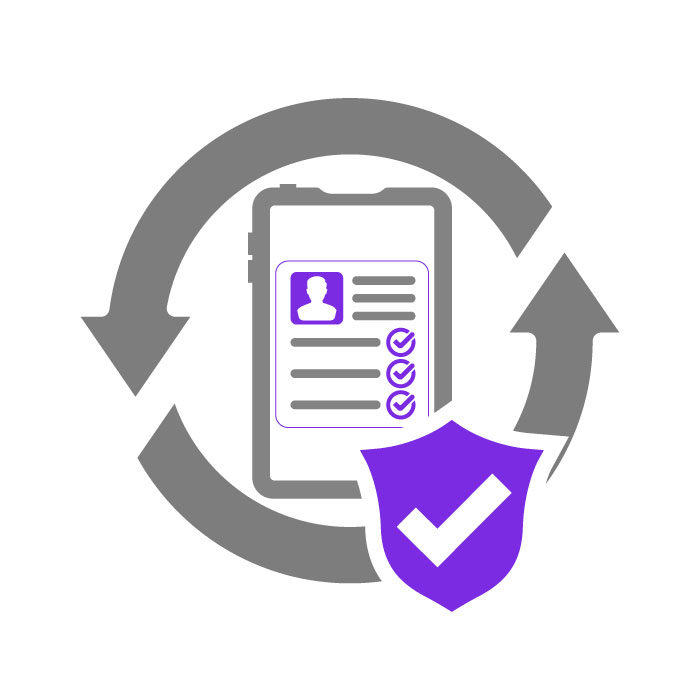Over 40% of financial institutions (FIs) are dealing with increased fraud and financial crime, putting more pressure on banks to choose between friction and security.
Quick overview: Conventional KYC methods are becoming obsolete. These outdated approaches demand time-consuming, manual processes that are inefficient for banks and tedious for customers. But the new era of KYC is here.
Reusable credentials: Reusable credentials are a revolutionary verification solution where the customer only has to verify themselves once. This cutting-edge technology removes friction from operations and fortifies every touchpoint (in the branch, app, contact center, etc.), ensuring heightened security. With reusable credentials, banks can:
- Stop fraud by reducing weak security points
- Take the pressure off your employee and prevent human error
- Create a better customer experience with seamless processes at every touch point.
Why this matters: This is the next step in identity verification. There is now a way to have less friction without having to sacrifice security through reusable credentials.
The big picture: Humans are human, which means we can make mistakes or be taken advantage of by social engineering.
For example, the State of Vishing Report found a 10% increase in compromises when the fraudulent caller was a female as opposed to a male caller. Reusable credentials instantly take care of this problem. Your customer will have a hyper-secure, encrypted credential that your employee will request.
No guesswork is involved. Your customers and employees know that the account is secure.
Dive Deeper
Why the Traditional KYC Methods Are Not Working
The Achilles’ heel of current KYC processes is its temporary nature.
Once the initial identity verification occurs during account opening, it becomes a one-time, non-reusable process. This leaves day-to-day interactions vulnerable, forcing employees to repeatedly verify customer information through methods susceptible to exploitation, such as:
- Security questions
- Teller judgments on IDs
- SMS verifications
- Over-the-phone verification.
Using reusable credentials allows customers to be seamlessly verified at every touch point. No reverification. No room for fraud. Only a seamless customer experience.
Stop Fraud with Reusable Credentials
In the continual battle against fraud, where every weak link in security can lead to losses, reusable credentials fortify FIs. Traditional KYC methods are vulnerable to social engineering and create an environment where fraud can thrive.
A FI employee shared their story showcasing that humans are unfortunately susceptible to social engineering:
“[A] member is claiming he attempted a deposit of $2,900 over the long weekend that was not processed … I thought it was a no-brainer. [The] account was [less than] 45 days old, and aside from the initial $10 deposit to open the account there was no other activity. There’s no way a supervisor would agree to PRCR. And yet, when the ticket came in, there was a comment that the Call Center’s director approved a PRCR of $1,500 “so the member can pay his bills.”
Sure enough, within an hour, the member pulled $800 out at another ATM. A few hours later, another $200. The next day, about a dozen or so $10 withdrawals from Cash App, and finally another ATM [withdrawal] of $330. [The] account now has less than $15.
Any odds on us seeing this $1,500 coming back to us? [The] call center rep feels bad because she is “normally a really good judge of character.”
The problem: Weak points of traditional security measures. Security questions, often easy targets for social engineering, can be guessed or manipulated. Bank tellers, despite their expertise, may struggle to differentiate between authentic and forged IDs. SMS-based verifications, a common practice, can expose customers to phishing attacks.
The solution: Embracing reusable credentials that close vulnerabilities for identity verification. By adopting an approach similar to the success of TSA Precheck in travel, banks can usher in a new era of fraud resistance. They provide a one-time, thorough verification during onboarding, making fraud attempts nearly impossible.
Fraud prevention is not just a reactive measure; it’s a company-wide initiative. Reusable credentials significantly reduce the workload associated with fraud-related projects, allowing financial institutions to reallocate resources.
💡 Learn more about how reusable credentials revolutionize bank KYC processes here.
Take the Pressure Off Your Employees
“Tellers are the first line of defense. It’s our job to protect your account. But we aren’t perfect. Just like any sort of defense, we make mistakes or miss things. We are human and are subject to human error.” – A teller talking about their experience.
The heartbeat of any financial institution is its dedicated workforce, tirelessly navigating the delicate balance between service and security. Traditional KYC and identity verification require manual processes and diverse verification methods that put immense pressure on employees to stop fraud while providing a great customer experience.
Reusable credentials revolutionize this situation by offering a streamlined solution that alleviates the pressure on bank employees. Employees are freed from repeatedly needing to validate customer information with a one-time, thorough verification during onboarding. This shift enhances operations and empowers employees to focus on delivering excellent customer experience.
The New Era of Bank’s KYC Process
As customer preferences evolve, coupled with the continual increase in fraud, banks must innovate. Partnering with a provider like Anonyome Labs, makes adding cutting-edge technology to existing operations easy.
Our technology includes everything needed to integrate reusable credentials into existing apps and systems without the need for a complete overhaul.
👋 Contact us today to see what Anonyome Labs and can do for your FI.
FAQ: Reusable Credentials and Decentralized Identity
What is the reusable credentials process?

- The First Identity Verification A decentralized identity (DI) system verifies a customer’s identity during account creation using robust authentication methods.

- Creation of Reusable Credentials: Once the identity is verified, the DI system generates a reusable credential. These credentials are encrypted, making them tamper-proof and incredibly secure.

- Customer-Controlled Data: Unlike conventional identity systems where the FIs oversee and store user data, decentralized identity transfers this to the customer. For banks, this translates to customers possessing their credentials securely stored on their devices, offering the convenience of storing and presenting credentials directly within your banking app and interfaces.

- Persistent Verification: Reusable credentials stop the need for repetitive verification processes. Whether logging into an app, contacting the call center, or visiting a branch, customers simply present their reusable credentials as irrefutable proof of identity.
What are the benefits for banks to use reusable credentials?
- Enhanced Security: Reusable credentials reduce reliance on traditional methods prone to fraud, replacing security questions susceptible to social engineering or SMS-based verifications vulnerable to phishing.
- Frictionless Customer Experience: Reusable credentials ensure a seamless and frictionless experience for bank customers to enjoy continuous and secure interactions across various touchpoints.
How can banks use reusable credentials to prevent fraud?
- The Highest Level of Security: Reusable credentials use advanced cryptographic techniques to make information tamper-proof and nearly eliminate the risk of fraud.
- Absolute Proof of Identity: Once a customer’s identity is verified and turned into a reusable credential, it becomes irrefutable proof of their identity, minimizing the risk of social engineering or phishing.
- Strengthen Security Points: Reusable credentials limit places where fraudulent activities can occur, minimizing potential attack points found in traditional verification methods.
Are reusable credentials being used in other industries?
Reusable credentials are gaining traction and being explored in various industries beyond finance, including:
- Healthcare
- Government services
- Education
- Farming
- Mining
- Travel and hospitality
- Retail and e-commerce
- Human resources and employment
Although widespread adoption is still evolving, various pilot programs and collaborations are underway to explore the potential of decentralized identity and reusable credentials in solving challenges and improving user experiences across industries.
👀 If you are not in the finance industry, don’t hesitate to reach out to see what reusable credentials through Anonyome Labs can do for your organization. Talk to us today!



